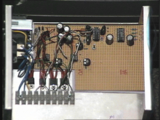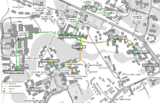New Broadcast Network
System options
Several options existed at the time with varying levels of expense
- A baseband signal sent over coaxial cable (with sound modulated on top)
- Digitising the signal in some way
- Using balanced line video and audio as tested in the Vanbrugh Upgrade
- Obtaining a license for a small transmitter
The development effort for an all digital system was prohibitively long, and while the coaxial system had merits in bandwidth terms the cost of the cable ruled it out. The decision was made to select twisted pair cabling on the basis that getting some new cabling installed was the most important step: a digital system could always reuse any cable in the future following an initial analogue installation.
Also, Owain Davies had contructed a 19" rack unit with 6 balanced line video outputs and matching audio drivers off his own back, so half of the transmission system was already built and tested.
The six transconductance amplifier outputs were allocated as
- LTC - Langwith - Derwent
- LTC - Vanbrugh
- LTC - Biology - Wentworth
- LTC - Library - Alcuin
- LTC - Central Hall - Physics - Goodricke
- LTC - Unused
the optional termination on the receiver boxes meant that extra receivers could be added to a chain as simply as looping a signal through a monitor, and moving the terminator to the last link in the chain.
New cabling
In summer 1998 an ambitious 2km of 3-pair plus overall screen cable was installed, following an initial mixup which had seen 2km of 3 core mains cable delivered to the station instead. This would be joined to portions of known good Rediffusion cable, notably the thicker solid core contribution cables in reverse.
Where terminated to the three pairs were assigned
- Red/black: video
- Green/black: left or mono audio
- White/black: right audio
though at the time of installation stereo audio stopped after the sound desk.
Timing was opportune as this was the same summer that a private contractor was installing about the same amount of cabling for the one-per-room campus telephones for student's bedrooms. Often a route could be covered by following the private contractors while the covered walkway panels were removed, though sometimes they followed the YSTV installation too.
The new cabling was anonymous and grey, so to help prevent it being cut in the future it was marked at each access point or missing ceiling tile with 'YSTV' on a band of yellow electrician's tape. This can still be clearly seen where some trunking is missing on the way up to the JB Morrell library as at 2007.
Key equipment
All of the best equipment was available to aid the team, including
- Some dowel previously used to hold up the Black drapes
- An old length of washing line
- A torch, well a couple of torches actually as one was left in the walkway outside Vanbrugh by mistake
- A step ladder
- The long step ladder borrowed from the Drama Barn
- An electric screwdriver and a bag of washers and screws - the walkways had lost many of their screws over the years
- Gaffer tape
Chief installers Tim Hackett, Rob Sprowson, and briefly Will Irvine and Alex Hudson worked unfeasably long hours to get all of the cabling in place for start of term. Peter Bowles also came in handy where cabling down small tunnels was required, it was easier to send down a low paid human than trying to push the cables through with rods.
Tricky bits
On the whole, the university's use of wooden covered walkways made cable installation fairly simple with a few notable exceptions
- The crossroads outside LTC and Central hall, massive bundles of other power cables, fire alarm cables, network and communications cables all met here and the walkway was completely full. A can of WD40 was used to grease the cables so that they could be dragged past this section
- Central hall, an impenitrable concrete fortress not intended to ever have any wires added to it once contructed
- The under road tubing from Biology to Wentworth, the tubing had blue pull through ropes so laying cables was quite simple, but the area was infested with thousands of itchy biting flies
- Over Vanbrugh kitchens, through the high voltage substation, with a little supervision from Steve Stead in Estates department
Receivers
The receiver units were all built by Rob Sprowson based on cloning the video receiver from Owain's Vanbrugh prototype, with the addition of an on board MAX497 distribution amplifier to directly drive up to 4 sets. The audio driver used was an SSM2142/SSM2141 transmitter and receiver pair, again balanced line, with two copies of the circuitry present to allow for future stereo transmissions (only one half was populated to save money).
With the exception of Vanbrugh, which had relatively new SCART capable televisions, an entire new set of Finlandia televisions were purchased from 'Tony and Brian' in the Midlands. Being ex-rental sets they automatically turned on to ITV via the tuner, and had to be modified internally with some minor track cuts and wire links to force them to switch to the external AV channel (while still appearing to be on ITV on the facia).
The advantage of this commonality meant that any faulty sets could easily be compared side by side with known working ones, and often it was necessary only to look at which components were clean in a working set to see where they had been repaired in one but not the other. For some reason the majority of the televisions smelt of cigarettes.
Lead by Paul Leader and later rebranded by Matt Hammond the monitors were all marked with laminated front panel sticker - often obscuring the redundant channel changer buttons, hinting at how to work the television in the absence of a remote control: a common failing of previous installations, being frequently maltreated by people trying to work out how to turn up the volume.
A service history sticker was added to the rear, but seldom used.
Start of term
Installing the bulk of the twisted pair was only half of the challenge, in each college permission had to be sought to install television receivers
- Alcuin - cables installed but receiver put on hold due to anticipated remodelling of the college nucleus
- Library - receiver box installed intended for the lean-to snackbar, but no power available and no TV installed
- Vanbrugh - existing TVs reused, prototype receiver and separate amplifier replaced with integrated receiver running off new cabling
- Langwith - JCR TV added to the network on a spare SCART socket, and sub optimal bar monitor location offered by the bursar Kevin Nicholson
- Derwent - was being remodelled the same summer, and a very favourable snack bar location was eventually given including bracket and dedicated electrical supply
- Central hall - cable left unterminated in a grid as this link was on a stub
- Physics concourse - intended to be wired baseband from the old P/X/002 studio
- Goodricke - left as wired from the studio directly, ultimately earmarked to come from LTC at a later date (incase YSTV ever moved from G/046 as part of a James/Goodricke/SU centre branch
- Biology concourse - due for remodelling, and since the cable passed through that area it could easily be spliced later
- Wentwork - receiver installed along with internal college wiring to the lower JCR, snackbar as it was then, and by virtue of its location the porter's lodge
In broad terms, although the heart had been ripped out of the Rediffusion system, at the start of Autumn 1998 the total network coverage was largely unchanged (Vanbrugh, Goodricke, Derwent, Langwith) except that now the images were in colour and on modern stereo sets.
Post fix additions
Estates
After the initial burst of activity in 1998, the remaining two years of Rob Sprowson and Chris Ward's time was largely occupied chasing estates to add the remaining missing pieces of the jigsaw puzzle. Resourcing within Estates meant that new YSTV monitors was never a top priority.
Locations
Some progress was made, though by graduation the network was still not as extensive as had originally been hoped. A number of small finishing off jobs remained, these were left for the following year's Network Engineer to complete.
- Alcuin - cables hastily retracted during nucleus demolition and left in a coil at the back door to the JB Morrell library, this work was conducted remotely after Rob Sprowson's graduation while working
- Library - a power point was located, but had only a live connection and no neutral, internal wiring was added to the snack bar by Chris Ward early one morning due to noise restrictions, and a set briefly installed on a bracket. Due to the lean-to contruction of the snackbar the TV inched forward every time the door slammed shut and the TV was hastily withdraw when it fell and nearly injured a student drinking a laté. The socket was scheduled to be repaired in summer 2000
- Vanbrugh - the snackbar television was modified to always turn on to YSTV rather than an off tuned terrestrial channel, and URY used the 4th output from the receiver, but otherwise Vanbrugh remained unchanged
- Langwith - used annually for conference services, eventually the receiver was modified to have a BNC connector on it to allow the mute monitor to be easily added and removed each summer
- Derwent - unchanged
- Central hall - a mains supply was added in the left hand pump room, and a receiver and coax output installed. The installation was completed on graduation day, spraying the newly washed windows with sawdust. The network cable itself remained unconnected in a manhole cover approx 2 feet away
- Physics concourse - not progressed
- Goodricke - not progressed
- Biology concourse - not progressed
- Wentwork - the television was borrowed and later empounded in the JCR store, this link remained a topic of frequent station meeting updates, seemingly always just one week away from completion
Network failure
In 1999 the new network failed spectacularly, twice. The first had followed a number of days of reports from Chris Ward that the Vanbrugh porter's lodge set was looking odd, and by implication the rest of the distribution network except Goodricke. Eventually the monitors went black.
This was traced to the Rediffusion unit in the Physics spine P/S/016 which converted from composite video to balanced line to get to LTC. Two electrolytic capacitors, operational since the mid 1960's had finally given up and a dash to Physics stores for their somewhat smaller modern day replacements brought the network back online.
The second incident was while P/S/016 was being redecorated, the decorators removed the fuse from the supply feeding the network box (as the box itself was hidden behind a wooden panel). A large 'DO NOT TURN OFF' label was added to help prevent a recurrence.
Documentation
To help with future work, a blue print of the university on A2 paper was obtained from Estates and marked with the new cabling routes along with joins to old Rediffusion routes and other similar annotations. This map was submitted back to Estates for inclusion on future drawings in the hope that this would avoid damage to cables.
A technical reference manual, in the same style as produced for the Cub Conversion and Station Video Mux was also produced, extending to 4 dense pages of A4 text plus copies of the schematics, stripboard layouts, and datasheets for the receiver units.
Contribution
Originally the only anticipated contribution was to be the link, via Physics, to the star point at the centrally located Language Teaching centre.
However, the move to Derwent of the student union elections for EN 99 meant that some rapid cable tracing was required. A balanced line driver was placed in the ceiling void above D/016 which allowed (via a choc block in Langwith) pictures to be received in LTC which were then relayed somehowUnverified or incomplete information back to Goodricke.
The system was extensively tested prior to the event by use of a BBC Micro generating a test pattern, also in the ceiling void, to a monitor in Goodricke.
In spring 2000 the link was revisited and the last remaining traces of Rediffusion equipment ripped out of LTC, the new cables fed discretely into the 19" rack unit (wall mounted vertically on wooden blocks), and rubberised Rediffusion cables cropped and labelled where known into a choc block patch panel. In theory this meant that any known good links could be reused in the same way that Derwent was by simply moving links around, with Derwent to Goodricke being the default state.


